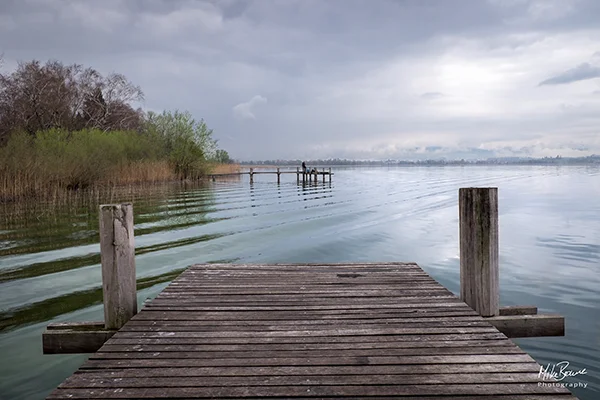Cloudy Days Photography
The location for this video is where we spend Day 1 of my Zurich Weekend Workshop.
When I was beginning my photographic journey, I used to think sunshine equalled great photos so unless it was shining, I didn’t bother. It’s a common mistake to make when you’re a beginner. Some photographers who’ve been shooting for years still think like this too.
Now it could be you just like to shoot in sunshine, which is fine. But cloudy days present brilliant opportunities because ...
- They’re a challenge and challenge is what makes us better
- Gaps between clouds give you get magical pools of light to play with
- Clouds add interest
One of the challenges is remembering that camera’s and eyes ‘see’ light differently. If you’d been standing on the shore of lake Pfäffikersee with me you’d have no trouble seeing me and the cloudy bright sky as normal. But as I said in the video, I was exposing for the sky so you could see it better. Even so, there are still burnt out highlights.
Eyes scan and feed image data to our brains, which make a kind of HDR so we can see details in light and shade easily. Cameras can’t - so what can you do about it?
You really have only three choices:
- Brighten exposure (expose for me) and let the bright sky burn out
- Darken exposure (expose for the sky) and let me be a silhouette
- Shoot RAW and make your own jpg in Lightroom or similar
Expose carefully to capture as much highlight and shadow data as possible. At 06:50 I increased exposure by 2/3rds (+0.7) of a stop because there was quite a bit of empty space on the right of the histogram (you can display them in the viewfinder on mirrorless cameras) and I prefer to capture as much shadow detail as possible, whilst not blowing highlights.
If you look carefully at the video insets where I show you composition, ask yourself if that picture looks natural? No it’s just like the main video because again, it’s through a camera - not eyes. I shoot RAW because I can make the image look more natural in post than the camera will.
Always remember the settings don’t give you pictures - pictures give you the settings.
What about those little pools of light I mentioned. Learn to look for them. Learn to see them and include them as part of your composition. This one was shot about 20 mins after filming, it’s the pool of light reflecting off the ripples from a passing boat that brings it to life.

We’ve still got the dock, cloudy sky and fisherman, the ripples are nice but it’s the light on them that makes it work, not just the ripples alone.
When it’s cloudy chances are the light and sky will be changing all the time. You can see it happening in this video, even though there was a very still day. So you have to be patient because clouds change shape and change the sky.
The images in the gallery at the end didn’t happen in ten minutes. It took another two hours of watching, exploring possible ideas, moving back and forth between them and waiting to see what happened to get the additional fifteen images at the end. Which I consider and exceptionally good crop of landscape images for so little time. You have to be patient and pay attention to what’s going on around you.
Cloudy days are great days for photography, but the same techniques of photography apply regardless of subject. Pre-visualise the picture and work back from that to find the settings you need to make it happen.
The first step is to learn which settings you need and what they do. Not just in technical terms such as making a manual exposure. You have to know what they do creatively too.
Have you ever wondered why there are three exposure controls - shutter, aperture and ISO? It’s because the first two have two purposes, one technical (exposure) and the other creative (movement or depth of field). If you didn’t have ISO, how would you be able to set the other two creatively whilst maintaining the correct exposure? My Masterclass In Photography online course will clear any confusion about this - and more.
If you want to stop be confused and frustrated by your camera and capture images you’re delighted to show off, get yourself on my beginners course. It’s online, guaranteed and you can try a free sample.
If you’re really serious, come with me in person and shoot this location with me as your guide and coach on my yearly Zurich Weekend Workshop…
Until next time….


























